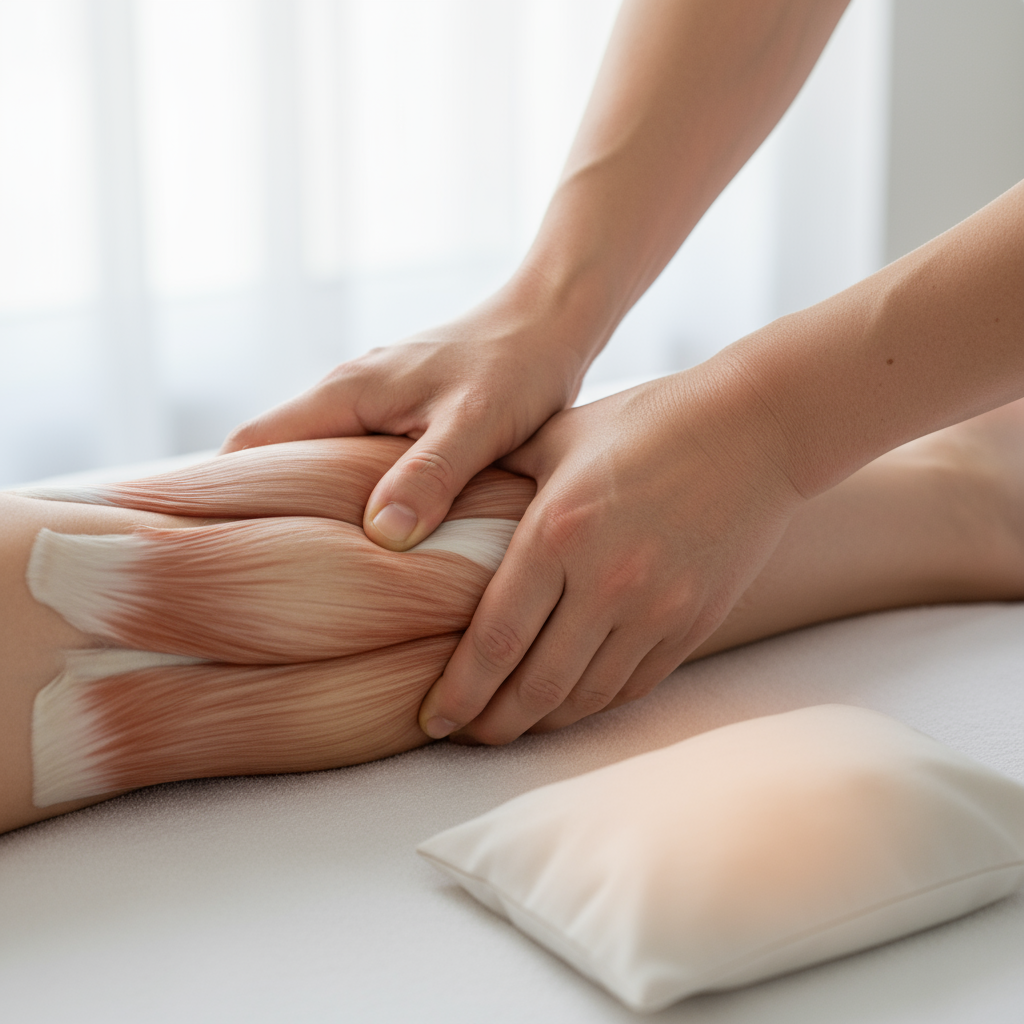
Table of Contents
Introduction
Ever been hit by a sudden muscle cramp that feels like someone just grabbed your leg and twisted? You’re not alone. Muscle cramps are those brutal, involuntary contractions that seem to have the worst timing—striking right in the middle of your workout or even when you’re just chilling on the couch. The sharp pain can literally stop you in your tracks, leaving you desperately searching for relief.
Here’s what’s usually going on behind the scenes. Your muscles cramp up for several reasons, but dehydration tops the list. When your body’s low on water or missing key minerals like potassium, magnesium, and calcium, your muscles basically throw a tantrum. Push yourself too hard during exercise? That muscle fatigue can trigger cramps too. The good news? Once you understand what’s causing them, you can tackle both the immediate pain and stop future episodes from ruining your day.
If you’re into fitness (or just getting started), dealing with muscle cramps is part of taking care of your body properly. Building up your endurance through fitness challenges for beginners actually helps condition your muscles to handle more without cramping up. Plus, the right strength training and stretching routine can make your muscles more resilient. Think of it as giving your muscles the tools they need to do their job without staging a revolt.
Let’s talk nutrition for a second—because what you eat and drink plays a huge role in muscle health. Those electrolyte-packed foods rich in potassium and magnesium? They’re like insurance for your muscles. Staying hydrated with the right fluids (especially after you’ve been sweating) keeps everything balanced. Want to dive deeper into how nutrition affects your overall health? Check out the role of a healthy nutrition plan and learn about benefits of regular physical activity for keeping your muscles happy and healthy.
What You’ll Learn in This Guide
Ready to kick those painful cramps to the curb? This guide is packed with natural, tried-and-true home remedies that actually work. We’re talking real solutions you can use right now to get relief, plus smart strategies to prevent cramps from coming back.
- Hydration and Electrolytes: Understand how maintaining proper hydration and replenishing electrolytes with mineral-rich fluids can alleviate and prevent cramps. Learn the best drinks and timing for optimal muscle function.
- Stretching and Massage Techniques: Discover targeted stretching routines and gentle massage methods that relax tight muscles, improve circulation, and bring fast relief from cramping sensations.
- Mineral-rich Diet: Explore key foods packed with magnesium, potassium, and calcium that naturally support muscle health. Learn how to integrate these nutrients into your daily meals for lasting benefits.
- Lifestyle and Prevention Tips: Gain insight into practical lifestyle adjustments including muscle conditioning, rest, and stress management that significantly reduce the frequency of painful cramps.
We’re going to break down everything you need to know about muscle cramps—what triggers them, how to spot the warning signs, and most importantly, what you can do about them right at home. No need for expensive treatments or complicated procedures. Just practical, effective remedies you can start using today, along with prevention strategies that’ll fit perfectly into whatever fitness routine you’ve got going.
Speaking of fitness routines—staying consistent with exercise is actually one of your best defenses against muscle cramps. (Who knew, right?) Learning how to stay motivated to exercise helps you build that consistency, which keeps your muscles conditioned and less likely to cramp up on you. And if you’re looking to boost your nutrition game, exploring plant-based protein sources can give your muscles the fuel they need for recovery and strength.
Your overall lifestyle choices matter more than you might think when it comes to muscle health. Simple things like staying properly hydrated can make a world of difference. That’s why checking out resources on how to prevent dehydration gives you practical tips that directly help prevent cramps. Building a solid nutrition foundation with balanced, nutrient-rich foods supports your muscles in ways you’ll definitely notice.
By the time you finish reading this, you’ll be armed with everything you need to handle muscle cramps like a pro. We’re talking about understanding what causes them, recognizing when they’re about to hit, and knowing exactly how to address them using safe, natural remedies you probably already have at home. Your journey to staying active, pain-free, and totally in control of your muscle health starts right here.

You know that sudden, sharp pain that hits your calf in the middle of the night? Or that nasty cramp that seizes your hamstring during a workout? Yeah, muscle cramps are the worst. These involuntary muscle contractions can strike out of nowhere, turning a peaceful moment into an uncomfortable (sometimes downright painful) experience.
Here’s the thing—muscle cramps happen to almost everyone. Whether you’re an athlete pushing your limits or someone just going about their day, these unwelcome visitors don’t discriminate. The good news? Once you understand what’s causing them and learn some practical ways to deal with them, you can take back control.
Let’s dig into what’s really happening when your muscles decide to rebel, and more importantly, what you can do about it. We’re going to explore the main culprits behind these cramps and walk through some tried-and-true home remedies that actually work. No fancy equipment needed—just practical strategies you can start using today.
Common Causes and Triggers of Muscle Cramps
So what’s really going on when your muscle decides to lock up? Most of the time, it comes down to a few key players: dehydration, overworked muscles, and your body’s mineral balance getting thrown off. Think of it like a perfect storm where everything aligns just wrong.
Dehydration is probably the biggest troublemaker here. When you’re not getting enough fluids, your body’s electrolyte balance goes haywire. These electrolytes—sodium, potassium, magnesium—are like tiny conductors orchestrating how your muscles contract and relax. Take them away, and suddenly your muscles are getting mixed signals.
Then there’s the overuse factor. Push your muscles too hard, too fast, or for too long without proper rest? They’re going to let you know they’re not happy. This is especially common if you’re jumping into intense workouts without building up gradually, or if you’re doing repetitive motions all day long.
But here’s where it gets interesting—poor circulation can also play a role. When blood flow to your muscles gets restricted, they’re not getting the oxygen and nutrients they need. It’s like trying to run a car on fumes. Eventually, something’s got to give.
All these factors often work together, which is why tackling muscle cramps requires looking at the bigger picture. You might want to check out our guide on fitness challenges for beginners to build up your muscle conditioning gradually, or explore best resistance training exercises to strengthen your muscles and reduce your risk of strain.
Key Factors Contributing to Muscle Cramps
Let’s break down the main troublemakers that team up to cause those painful cramps:
- Dehydration and Electrolyte Imbalance: When you’re not drinking enough water, your body’s mineral balance gets messed up. Sodium, potassium, and magnesium all help your muscles work properly. Lose too much through sweat (especially on hot days), and your muscles start misfiring.
- Muscle Overuse and Fatigue: Push too hard, too fast? Your muscles will push back. This happens a lot when people skip warm-ups, jump into intense exercise, or do the same motions over and over without breaks. Your muscles need time to recover.
- Mineral Deficiencies: Not getting enough potassium, magnesium, or calcium in your diet? Your muscles feel it. These minerals are crucial for proper muscle function and nerve communication. When levels drop, cramps become much more likely.
- Poor Blood Circulation: If blood isn’t flowing well to your muscles—especially in your legs—they’re not getting the oxygen and nutrients they need. This can lead to pain, cramping, and slower recovery after exercise.
Once you recognize these patterns, you can start targeting the real causes instead of just dealing with symptoms. The goal is creating a lifestyle that keeps your muscles happy, hydrated, and well-nourished. That’s your best defense against future cramps.
Effective Home Remedies and Prevention Strategies for Muscle Cramps
Okay, so you’ve got a cramp—now what? The good news is that most muscle cramps respond really well to simple home treatments. No need for expensive gadgets or complicated procedures.
First things first: stretch it out. Gently. I know it hurts, but slowly stretching the cramped muscle and giving it a gentle massage can work wonders. You’re basically coaxing the muscle to relax by increasing blood flow and loosening up those tight fibers.
Heat and cold can be your best friends here. Heat (like a warm bath or heating pad) helps relax tight muscles, while cold can numb the pain and reduce any inflammation. Some people swear by alternating between the two.
And let’s talk hydration—but not just water. When you’re dealing with cramps, especially after sweating, you need to replace those electrolytes too. Sports drinks work, but so does coconut water, which is packed with natural potassium and magnesium.
Your diet plays a huge role in prevention. Foods rich in magnesium and potassium—think bananas, leafy greens, nuts—can help keep your muscles functioning smoothly. It’s like giving your muscles the fuel they need to do their job properly.
Want to build better habits overall? Our guide on how to start a fitness routine can help you develop consistent exercise patterns, while how to maintain a balanced diet offers practical tips for getting those muscle-supporting nutrients.
Practical Remedies and Lifestyle Adjustments
Here are the strategies that really work when you put them into practice:
- Stretching and Massage: Gentle stretches before bed or after exercise can prevent nighttime cramps. Self-massage or foam rolling boosts circulation and keeps muscles loose. Even just a few minutes makes a difference.
- Heat and Cold Therapy: Warm baths or heating pads relax tight muscles, while ice packs can numb sudden, sharp pain. Find what works for you—some people prefer one over the other.
- Electrolyte Hydration: Plain water isn’t always enough. Coconut water, sports drinks, or even adding a pinch of sea salt to your water can help replace the minerals you lose through sweat.
- Balanced Nutrition: Load up on magnesium-rich foods like almonds and spinach, potassium powerhouses like bananas and sweet potatoes, and calcium sources like dairy or fortified plant milks. Your muscles will thank you.
The key is consistency. These aren’t one-and-done solutions—they work best when you make them part of your regular routine. Warm up before exercise, stay hydrated throughout the day, wear proper shoes, and listen to your body when it’s telling you to slow down. Take care of your muscles, and they’ll take care of you.

You know that awful feeling when a muscle cramp hits? That sudden, sharp pain that stops you dead in your tracks—whether you’re mid-workout or just trying to sleep. Muscle cramps are basically your muscles throwing a tantrum, contracting involuntarily and refusing to let go. The usual suspects behind these painful episodes? Dehydration tops the list, followed by overworked muscles, low levels of key minerals like potassium and magnesium, and poor blood flow. Once you understand what’s triggering your cramps, you’re already halfway to beating them. Watch for the telltale signs: that sudden tightness, the sharp pain that makes you wince, and sometimes a little muscle twitching that lets you know trouble’s brewing.
Here’s the good news—you don’t need fancy treatments to find relief. Simple home remedies work surprisingly well. Gentle stretching and massage can work wonders by encouraging blood flow and helping those stubborn muscle fibers relax. Heat packs feel amazing on cramped muscles, while cold packs tackle inflammation head-on. But here’s what many people miss: staying hydrated isn’t just about water. Your muscles crave electrolytes, so reach for coconut water or add a pinch of sea salt to your drink. Load up on magnesium-rich foods like dark leafy greens, potassium from bananas, and calcium from dairy. These nutrients are like fuel for healthy muscle function. Pair these remedies with smart lifestyle choices—regular exercise that builds muscle endurance, proper warm-ups, and managing stress—and you’re setting yourself up for stronger, more resilient muscles.
Prevention really is your best friend when it comes to muscle cramps. Think of hydration as your daily insurance policy, especially if you’re active. Your muscles need that fluid balance to work properly. Before any workout, take a few minutes to warm up—your muscles will thank you later. Good ergonomics at work? Absolutely crucial, especially if you’re sitting all day. Keep feeding your muscles the nutrients they need through a balanced diet. Listen to your body, too. Pushing through fatigue often backfires. Rest days aren’t lazy days—they’re smart days. But here’s when you shouldn’t tough it out: if cramps become frequent visitors, stick around longer than they should, or come with scary symptoms like numbness or swelling, it’s time to chat with your doctor. Sometimes cramps signal something bigger that needs attention.
Ready to take your muscle health to the next level? Since you now understand what causes cramps and how to handle them, let’s talk about building the kind of strength that prevents them in the first place. Check out our guide on fitness challenges for beginners—it’s packed with safe, effective ways to build muscle strength while keeping injury risk low. Staying consistent with exercise can be tough, so our tips on how to stay motivated to exercise will keep you on track. And since we’re talking prevention, don’t skip the cool-down. Our guide to the best post-workout stretches shows you exactly how to keep those muscles happy after a workout. For a deeper dive into the medical side of cramp prevention, the resource at how to prevent muscle cramps offers valuable insights into the physiological factors that go beyond basic fitness.
You’ve got the tools now—time to use them. Managing muscle cramps isn’t rocket science, but it does require consistency. Stay hydrated, eat well, exercise smart, and listen to your body. These aren’t just quick fixes; they’re lifestyle changes that pay dividends in the long run. Your muscles will become more resilient, cramps will become less frequent, and you’ll feel more confident in your body’s ability to handle whatever you throw at it. Start small, stay consistent, and remember—every healthy choice you make today is an investment in tomorrow’s comfort and mobility.
Frequently Asked Questions
-
What foods help prevent muscle cramps?
- Foods rich in potassium, magnesium, and calcium such as bananas, spinach, and dairy products help prevent cramps by supporting proper muscle function.
-
How quickly do home remedies relieve cramps?
- Remedies like stretching and hydration can provide relief within minutes to hours by relaxing muscles and restoring electrolyte balance.
-
Can dehydration cause muscle cramps?
- Yes, dehydration is a common trigger as it disrupts electrolyte levels essential for normal muscle contractions.
-
Is it safe to use heat or cold packs?
- Yes, applying heat helps relax muscles and cold reduces inflammation; both are safe when used properly and can ease cramping.
-
When should I see a doctor for muscle cramps?
- If cramps are severe, frequent, persist despite home treatments, or are accompanied by numbness or swelling, you should seek medical advice.
